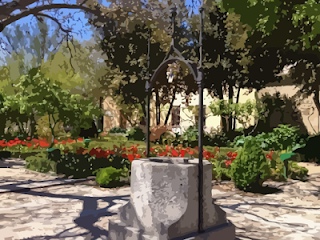 Only a woman had the strength and courage to command the weak and scanty forces of men who raised the cry of their freedom.
Only a woman had the strength and courage to command the weak and scanty forces of men who raised the cry of their freedom.The night in which his Christian companions of Rabal Roig would have been murdered at the hands of the invading Arab.
Hermenegilda-Eugenia "the Armengola" nurse of the warden's children had in their hands the lives of their countrymen.
He preferred to betray his Moorish master rather than to see the blood of those whom he loved to be shed.
Thus he devised a plan worthy of a Greek epic.Instead of accompanying her daughters to the interior of the castle, two of the bravest men of the Christian side, disguised as they (Ruidoms and Juan de Arnúm), would kill the Moorish alderman Aben Mohor.
And just as they planned so it happened.
Sentinels from the guard posts fell under the edge of their knives.
And finally they ended the life of the one who wanted to do the same with theirs.
But when they reached the interior of the castle some lights in the sky were shown to give value to the feat.
Some holy forms were formed and the Christians vowed to see Santas Justa and Rufina.
And that infused more value for the fierce fight that maintained against the remaining Moors.
The courageous wife of Pedro Armengol, wielding arms and fighting like a man, did prodigies of valor.
Finally, the death of the alcalde, the taking of the castle at the hands of the Christians of Orihuela and the encounter with the saving army of king Don Jaime caused the Mudejar Moors to desist from their commitment to carry out the planned massacre.
And this became a tradition among its citizens and every year, in July are celebrated the Moors and Christians of the City of Orihuela which are the symbol of the Reconquest.
Therefore, the most important figure of Orihuela could be said to be the figure of the Armengola.
Each year an oriolana is selected to represent this figure.
It is surely the most important and emblematic person of our beloved city.
This year, 2012 the chosen one, I'm very happy to say, has my own blood.
My sister Mariola that knowing her would not have surprised me that she herself with her courage and courage would have been able to perform the feat in the dark epoch.






